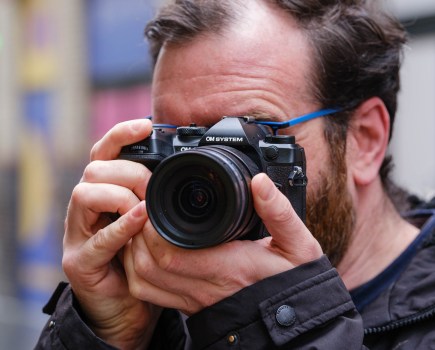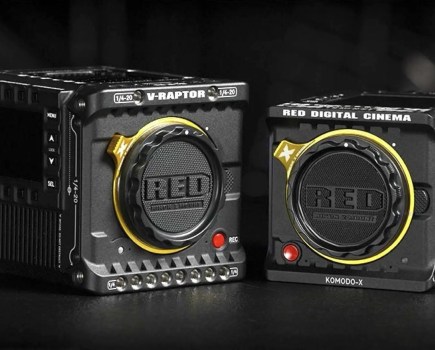I was a little surprised when Panasonic unveiled its Lumix DMC-GF3. Knowing the model name before the announcement, I was naturally expecting a successor to the GF2, or at least a camera that was above the GF2 in the G-series range. So when the first image of the camera appeared during the presentation, I was taken aback to see a far smaller camera designed for the consumer market.

At first glance it seems the GF3 has far more in common with the Sony NEX series than it has with previous Lumix G-series models. Like the cameras in the NEX range, the GF3 is designed like a large compact, with very few buttons placed around a new main control dial. There is also the notable omission of a hotshoe, with a central spring-loaded pop-up flash fitted instead.

As the GF3 is aimed at a lower end of the market than the GF2, it makes sense to use the older, 12.1-million-pixel sensor rather than the new 16-million-pixel sensor of the Lumix DMC-G3. This leaves room in the future for the next model, presumably the GF4, to include the higher-resolution sensor.

For enthusiast photographers, the details of the GF3 may not seem particularly promising. A camera that is smaller and lighter than the GF2, with few controls, no hotshoe and only a 12.1-million-pixel sensor is certainly not going to be at the top of many people?s wish lists. However, while using the GF3 to shoot around the streets of Rome, the possibilities of the camera became more apparent.
Handling
The biggest fear with any minimalist camera is that it will be awkward to operate and use. This was our concern with the first Sony NEX cameras, and it is something the company has gone some way to improving in its more recent models. Although the GF3 may lack the number of direct access buttons of other G-series cameras, it does have the same basic quick menu that makes it easy and logical to change most settings. The GF3?s major advantage over Sony?s NEX cameras is that it uses the same 3in, 460,000-dot touchscreen as Panasonic?s other current G-series models. Combined with the quick menu, the touchscreen makes changing settings fast and logical, and the lack of buttons isn?t a noticeable hindrance.
Autofocus
The inclusion of a touchscreen means that the GF3 uses the same touch AF and touch shutter features as other cameras in the G-series range. This means you can touch the area on the screen that you wish to focus on and the camera will take the image. As on the G3, the entire touchscreen can be used on the GF3 for this purpose.
In terms of AF speed, Panasonic claims that the camera can focus from 2m to infinity in just 0.18secs when using the Lumix Vario HD 14-140mm f/4-5.8 lens, thanks to the fast Venus VII HD processing engine that is similar to that fitted in the GH2 and G3. In practice, the AF speed was very snappy when using the 14mm pancake lens, although I?m looking forward to seeing how it performs with a variety of lenses when we test the camera fully in a July issue of AP.
Image quality
The sensitivity range of the GF3 is a sensible ISO 160-6400, which should meet the demands of most photographers. I was hoping that the 12.1-million-pixel resolution would offer improved noise control when compared to images produced by Panasonic?s other models that have this sensor fitted. From what I have seen so far, though, there doesn?t appear to have been a great deal of improvement at higher sensitivities. However, this may change before the final version of the camera is released, so look out for more on image quality in the main test.



At lower sensitivities, images look like those from the G2, being well exposed with a good level of colour and contrast. Given the size of the camera, I particularly enjoyed switching to the GF3?s black & white image style and taking street photography images. Its discreet, compact size, particularly with the 14mm pancake lens attached, made the GF3 ideal for this task.
Video
Panasonic is particularly keen to push the video capabilities of its cameras, and the GF3 is no exception. Its 12.1-million-pixel sensor and Venus VII HD processing engine can capture full 1080i video output at 25fps, with full-time autofocus and AF tracking. However, bearing in mind it is aimed at the consumer market, it does lack an external microphone socket and on-board audio can only be recorded in mono.
Conclusion
For a camera of its size, the Panasonic Lumix DMC-GF3 is surprisingly easy to handle. Potentially, its target audience is not only entry-level photographers, but also enthusiasts looking for a more portable camera. We have been waiting a while for a micro four thirds camera of this size and it will be interesting to see how it performs when we put it through its paces in a full test.
The GF3 is expected to be available in mid-July in three kit versions. The cheapest of these will be the GF3 with 14-42mm OIS zoom lens, which will cost £499. The GF3 with pancake lens kit, featuring the 14mm optic, will retail for £549, while a kit with the GF3 and both lenses will cost £629.







